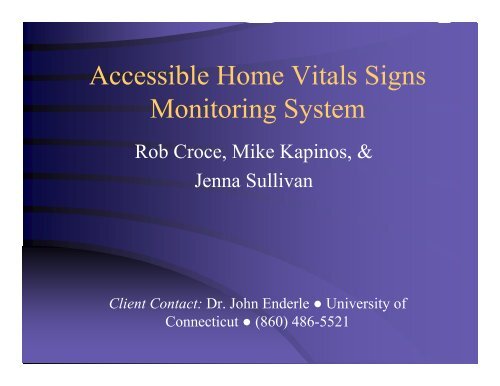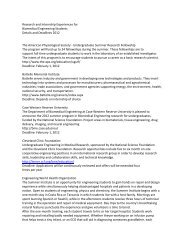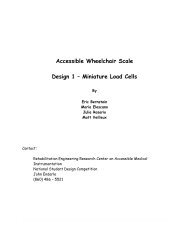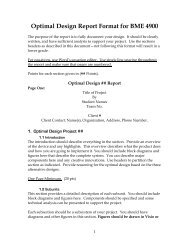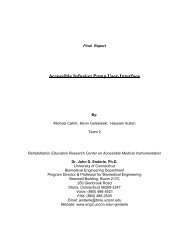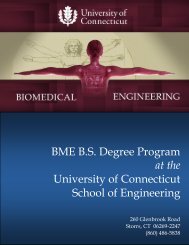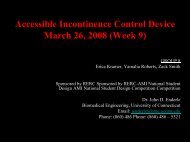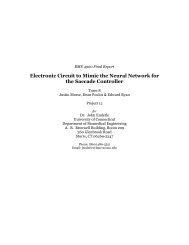Proposal Presentation - Biomedical Engineering - University of ...
Proposal Presentation - Biomedical Engineering - University of ...
Proposal Presentation - Biomedical Engineering - University of ...
You also want an ePaper? Increase the reach of your titles
YUMPU automatically turns print PDFs into web optimized ePapers that Google loves.
Accessible Home Vitals SignsMonitoring SystemRob Croce, Mike Kapinos, &Jenna SullivanClient Contact: Dr. John Enderle ● <strong>University</strong> <strong>of</strong>Connecticut ● (860) 486-5521
Outline• Background Information• Clients• Similar Devices• Accessible Home Vital Signs MonitoringSystem• Budget• Conclusion
RERC on AMI National StudentDesign Competition• Rehabilitation <strong>Engineering</strong> Research Centeron Accessible Medical Instrumentation• Open to biomedical engineering, industrialdesign, and related programs• Up to $2000 reimbursement for design costs
Home Health Care• About 7.6 million individuals receive homecare in the United States• 69.1% 65 years or older• Not only cost effective but also a humaneand supportive way to deliver health care• 23.4% use medical devices
Clients•Mat– Good physical condition, blind, small stroke•Sani– Head injury, partially paralyzed on right side• Dolores– Deaf, severe arthritis, heart problems
Accessibility Objectives• Device must be usable by the vision andhearing-impaired• Require little force and little fine motorcontrol• Easy to operate for all ages and abilities• Unobtrusive appearance
Current ModelsWelch Allyn Vital Signs Monitor300 SeriesDRE Philips SureSigns VS1Vital Sign MonitorSpecifications• 10” by 6” by 6.6”• 5.4 lbs• Approximate Cost: $3000Specifications• 9.4” by 9.8” by 9.3”• 8 lbs• Approximate Cost: $2000
Current Model Lackings• Unable to store vital signs <strong>of</strong>f <strong>of</strong> device• Vital signs transmitted via phone line (3 rdparty)• No auditory output• Designed primarily for use by health carepr<strong>of</strong>essionals• Buttons not fully accessible
Accessible Home Vital SignsMonitoring System Overview• Measure four vital signs: heart rate, bloodoxygen saturation, blood pressure, and bodytemperature• Save measurements to USB flashdrive• Transmit vital signs to health care providervia a secure website
Accessible Home Vital SignsMonitor• Large well-lit LCDscreen• Raised buttons withBraille or universalsymbol• Handle for portability• Speaker for auditoryoutput and prompts• Alarm on top
Accessible Home Vital SignsMonitorFigure BInstrumentPortsThermometer2"1"On/Off2/3"On/OffUSB Port• Instrument ports• On/Off button• USB portBlood Pressure CuffPulse OximeterUSB Port
Accessible Home Vital SignsMonitor• Power cable• Bag to holdinstruments
Secure Web Site• Maximizes patientprivacy• Allows patients totransmit vital signsfrom any internetconnected PC• Removes 3 rd partyfrom monitoringsystem
Budget• To the right is a tableshowing the expectedcost to construct thedeviceProductPlastic CasingMicroprocessorCircuit BoardPower CordRechargable BatteriesLCD ScreensCost$30$69$204$3$13$7SupplierMouserMouserPCBexpressMouserAmazonMouserElectrical Components$40Newark in One• Expected total cost <strong>of</strong>the prototype is $700which is 35% <strong>of</strong><strong>of</strong> our $2000 totalbudgetUSB PortButtonsComputer S<strong>of</strong>tware(Security)AlarmTransducers (BP Cuff,thermometer, SpO2probe)USB Flashdrive$7$6$30$15$200$60Newark in OneHappcontrolsTagLock Pro.EpillDREMedSanDiskSpeaker$16Newark in OneTotal:$700
Conclusion• Current products are very expensive so our main aimis to design an affordable device• The device must meet the needs <strong>of</strong> our clients• The device and computer system will be very easy foranyone to use• With our design, we plan to increase our clients’quality <strong>of</strong> life while continuing to closely monitortheir health
References• “Basic Statistics About Home Health Care.”National Association for Home Care &Hospice.” 2004. .• “Number <strong>of</strong> current home health care patients, bytype <strong>of</strong> aids, devices used, sex, and race:United States, 2000.” Current Home CarePatients. Feb. 2004.


